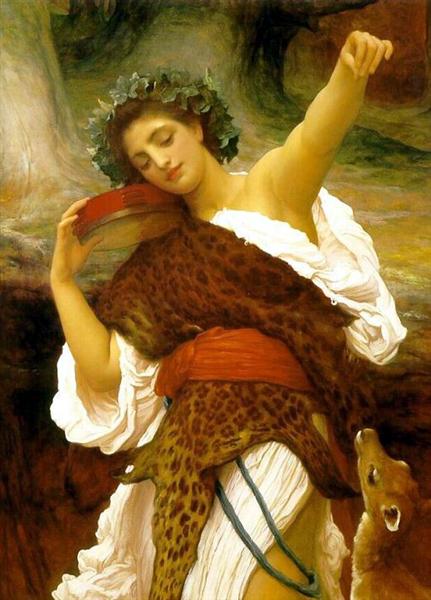Description
Frederic Leighton's Bacchante, painted in 1895, is a vibrant illustration of the late Neoclassical aesthetic, marked by the detail and splendor of the Pre-Raphaelite movement of which Leighton was a prominent exponent. The painting evokes a sense of celebration and freedom, capturing the essence of classical mythology in its depiction of a Bacchante, a priestess of Bacchus, the god of wine and festivity. The central figure is presented in dynamic, fluid movement, her costume covered by a light cloak that flows gracefully, almost as if she were dancing to the rhythm of inaudible music.
The composition of the work is particularly fascinating for its deliberate and balanced use of space. The Bacchante, in the visual core, stands against a dark background, which highlights her figure by creating a striking contrast. This play of light and shadow, inherent to Leighton’s style, not only serves to highlight the shape of the female body, but also evokes an atmosphere of mystery and depth, showing how light defines and shapes the physical features of the figure. The rich texture of the cloak is one of the most outstanding virtues of the work; the skilful use of paint and the use of terracotta colours, gilt and emerald green draperies suggest a softness that contrasts elegantly with the firmness of the Bacchante’s posture.
Another notable aspect is the figure's expression. Although the woman does not look directly at the viewer, her pose and the turn of her head reveal an intimate connection with her surroundings, as if she were part of a ceremony or celebration taking place out of sight. This suggestion of movement is imbued with sensuality and a sense of transcendence; her arm extended into the air suggests a surrender to the pleasure and exuberance of life. This is revealing of Leighton's ability to capture not only the physical appearance, but also the emotive and symbolic essence of her subjects.
Furthermore, it is interesting to consider the historical context in which Leighton created this work. In the late 19th century, the spirit of classical mythology and the search for idealism in art were significantly in vogue in Europe. Leighton's work, in particular, can be seen as a bridge between the classicist tradition and the emerging trends of modernism, manifesting the tension between idealized representation and the realities of the human body. Reproductivity and the use of living models were common practices among artists of this period, and Leighton's approach aligns well with his admiration for Italian Renaissance art, as well as its interaction with the forms and nuances of human expression.
The theme of the Bacchante is a recurring one in art history, connected with the exploration of the female figure in relation to mythology, nature and the celebration of life. Leighton's "Bacchante" can be compared to other works such as Jules Bastien-Lepage's "La Baccante" and works by other Pre-Raphaelites that address similar themes, emphasizing freedom of expression and the search for beauty.
In short, “Bacchante” is a work that transcends its mere visual representation; it is a dialogue between art and the philosophy of existence. Through his technique, his balanced composition, and his rich color palette, Frederic Leighton not only immortalizes the figure of the Bacchante, but also invites the viewer to join in the celebration of the body and its possibilities. With each glance, the work offers new layers of emotion and meaning, securing its place in the canon of art, while paying strong homage to its classical roots.
KUADROS ©, a famous painting on your wall.
Hand-made oil painting reproductions, with the quality of professional artists and the distinctive seal of KUADROS ©.
Painting reproduction service with satisfaction guarantee. If you are not completely satisfied with the replica of your painting, we will refund 100% of your money.

